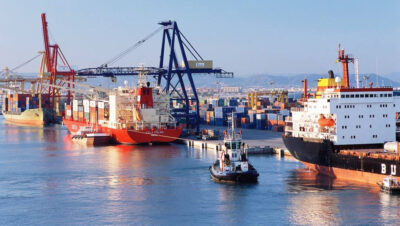>>REAL-TIME UPDATES IN THE WIRE. CLICK HERE<<<
Orders for new cargo vessels and containers have surged in the first two months of this year, as the world’s major shippers rush to cash in on soaring demand for freight along routes in the Pacific Ocean, buoyed in part by strong exports from China, according to global shipping services provider Clarksons.
As of March 1, global shipyards had received orders for 66 new container ships so far this year, representing 2.45 million in revised gross tonnage and driving up the total demand for containers to 530,000 twenty-foot equivalent unit (TEUs) at a cost of over $4.6 billion, according to data on released by Clarksons this month.
If the current pace of demand continues, the amount of new containers might surpass that of 2019, or even 2020, which stood at 770,000 TEUs and 990,000 TEUs, respectively, according to Clarksons’ data.
Seaspan, the world’s largest independent charter owner and manager of containerships, recently announced to new orders of a total of 18 vessels of 258,800 TEUs. Meanwhile, Taiwan shipping companies Wan Hai Lines also said it plans to order five cargo vessels of 65,000 TEUs. The data released by Clarksons didn’t include the latest orders by Seaspan and Wan Hai Lines.
Meanwhile, Taiwan shipping company Evergreen Marine Corp is currently in talks to order 20 vessels of 300,000 TEUs. The company said in early February that it’s inquiring prices of the 20 vessels and it will announce it when the discussions close.
The 18 vessels ordered by Seaspan include 4 vessels of 12,000 TEUs, 10 vessels of 15,000 TEUs and 4 vessels of 15,000 TEUs as backup, which will be delivered between the second half of 2022 and the third quarter of 2023. According to Chinese mainland news outlets, four of the vessels of 15,000 TEUs will be built by China’s Jiangsu Yangzijiang Shipbuilding Group Ltd.
Before the pandemic, new orders for the ships that carry about 80 per cent of global goods trade struggled to recover from the 2016 bankruptcy of South Korea’s Hanjin Shipping, then one of the top-10 players. That shock disrupted supply chains for weeks but also made it tougher to secure longer-term financing needed to purchase ships that can cost $150 million each and take two years to build.
The global health crisis reversed those fortunes, leading to a surge in online demand for goods that allowed the carriers to charge three to four times higher rates for freight across the Pacific than they could a year ago.
According to Clarksons Research, the order book as a share of existing fleet capacity has rebounded from the lowest level in more than 30 years. Since early October, orders for new container ships have increased by 115, with new container capacity of more than 1.1 million 20-foot equivalent units, or TEUs. That’s raised the total capacity on order to about 2.7 million TEUs, or almost 12 per cent of the existing fleet.
While that still represents a “relatively low order book” historically, “we expect it to edge up further in the coming months,” said Stephen Gordon, managing director at Clarksons.
Shipping companies seem to be more disciplined about investing in new ships, and some look to be more focused on looking for new sources of revenue or shareholder value, Kapoor said. There have not been signs of speculative ordering, which has happened in the past when the industry improved, he said.
Since the second half of 2020, demand for freight along routes in the Pacific Ocean including those from China have stayed robust, which sent shipping rates soaring, according to Clarksons.
At the end of 2020, SCFI index hit a new record high of 2,783, rising 56 per cent from the average level in 2019.
Into 2021, shipping rates continued to surge. In mid-January, China COSCO Shipping Corporation Limited leased two vessels of 80,000 TEUs for three years at a rent of $38,000 per day. That’s significantly higher than $31,000 per day in the month before and $12,000 yuan in June last year.

